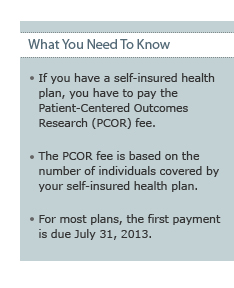Labor and Employment Alert: Health Plans Must Pay Patient-Centered Outcomes Research Fee and Other Employee Benefits News
Why the new fee?
The Patient Protection and Affordable Care Act (PPACA) established the Patient-Centered Outcomes Research Institute to study the effectiveness of various treatments. The Institute's work will be supported by the Patient-Centered Outcomes Research (PCOR) fee. 
The IRS released proposed regulations (available at http://federalregister.gov/a/2012-09173) on April 12, 2012, explaining how the PCOR fee is to be calculated and paid. Even though the regulations are only proposed, you are expected to follow them pending publication of final regulations.
Who pays the PCOR fee?
The PCOR fee applies to both health insurance and self-insured group health plans. Responsibility for the fee depends on funding. The insurer has to pay the fee for insured group health plans and individual health insurance policies (but not stop-loss policies issued in connection with self-insured health plans). The plan sponsor (generally, the employer) has to pay the PCOR fee for self-insured group health plans. The focus of this alert is how employers – as health plan sponsors – must calculate and pay the PCOR fee.
What plans are subject to the PCOR fee?
In general, the PCOR fee applies to any medical plan that is not an "excepted benefit." The table below lists types of plans that are subject to the PCOR fee and others that are exempt.
|
|
Plans Exempt from PCOR Fee |
|
|
Special Rule for Multiple Self-Insured Plans: The proposed regulations contain a special rule for a plan sponsor with multiple self-insured plans. If a plan sponsor has more than one self-insured health plan with the same plan year, the plan sponsor may treat the plans as a single plan and pay a single PCOR fee. This avoids multiple assessments for an employee who is enrolled in more than one self-insured benefit (like your medical plan and an HRA). Note, however, this special rule does not avoid double assessments where some benefits are insured and some are self-insured. For example, if an employee is covered by an insured medical plan plus a self-insured HRA, the insurer would have to pay the PCOR fee for the insured medical plan and the plan sponsor would have to pay a separate PCOR fee for the HRA.
FSAs: Most FSAs are excepted benefits and are not subject to the PCOR fee. An FSA is generally an excepted benefit if: (a) employees who are eligible for the health FSA are also eligible for medical benefits; and (b) either (i) the FSA is funded solely by employees' salary reduction contributions, or (ii) the employer's contribution to the FSA does not exceed the greater of (A) $500; or (B) twice the employee's salary reduction contribution.
When does the PCOR fee apply?
You will have to pay the PCOR fee for seven years. The PCOR fee applies to plan years ending after October 1, 2012 and before October 1, 2019.
The PCOR fee will be reported on IRS Form 720 and paid annually. The form and payment will be due July 31 for all plan years ending in the preceding calendar year.
Plan Year Ending DateFiling Due Date
| October 1, 2012 - December 31, 2012 |
July 31, 2013 |
| January 1, 2013 - December 31, 2013 |
July 31, 2014 |
| January 1, 2014 - December 31, 2014 |
July 31, 2015 |
| January 1, 2015 - December 31, 2015 |
July 31, 2016 |
| January 1, 2016 - December 31, 2016 |
July 31, 2017 |
| January 1, 2017 - December 31, 2017 |
July 31, 2018 |
| January 1, 2018 - December 31, 2018 |
July 31, 2019 |
|
January 1, 2019 - December 31, 2019 |
July 31, 2020 |
If a group health plan covers the employees of two or more entities in a controlled group and a plan document designates a specific entity in the group as the plan sponsor, the plan sponsor files the Form 720 for all entities with employees participating in the plan.
If a group health plan covers the employees of two or more entities in a controlled group but a plan document does not designate a plan sponsor, each entity with employees participating in the plan must file a separate Form 720 based on its employees and their family members. If the entities want to file a single Form 720, they have until the first due date to designate a plan sponsor for purposes of the filing.
How much is the PCOR fee?
For the first year, the PCOR fee is $1.00 multiplied by the average number of covered individuals. For the second year, the PCOR fee is $2.00 multiplied by the average number of covered individuals. For the third through seventh years, the $2.00 is indexed based on increases in national health expenditures.
The PCOR fee is based on the average number of covered individuals, not just covered employees. The proposed regulations provide the four options for calculating the average number of covered individuals, plus two special rules.
- Actual count method: Count the actual number of covered individuals on each day of the plan year and divide by the number of days in the year (365 or 366).
- Snapshot count method: Count the actual number of covered individuals on at least one day in each quarter of the plan year and divide by four (or the number of sample days).
- Snapshot factor method: On at least one day in each quarter of the plan year, count:
- the actual number of employees enrolled in single coverage; and
- the actual number of employees enrolled in coverage that includes at least one family member (e.g., employee plus spouse, employee plus one or more children, and family coverage) and multiply that number by 2.35.
Divide the total by four (or the number of sample days).
- Form 5500 method: If the plan offers family coverage, add the number of participants reported at the beginning of the year and the end of the year. Since the participant counts on Form 5500 do not include family members, this doubling of the number of reported participants is intended to reflect the fact that some reported participants have coverage for family members. However, if the plan does not offer family coverage, the total may be divided by two to reflect the average number of participants during the plan year.
Special rule for first year: For a plan year that starts between October 2, 2011 and July 11, 2012 (90 days after the proposed regulations became publically available on April 12, 2012), you can use any reasonable method of determining the average number of covered individuals.
Special rule for FSAs and HRAs: If you have an FSA or HRA that is subject to the PCOR fee, enrollment in an FSA or HRA is always treated as single coverage. You do not need to take into account the fact that the FSA or HRA can be used to reimburse medical expenses incurred by family members.
You have to pick one method for all coverage (other than FSAs and HRAs) reported for a plan year but you are free to change methods for future plan years.
Other Employee Benefits News
Supreme Court decision expected near the end of June
As widely reported, the Supreme Court's decision on the constitutionality of the individual mandate is expected around the end of June. If (and only if) the Supreme Court finds the individual mandate to be unconstitutional, the Supreme Court will also decide what other provisions of PPACA should be struck down along with the individual mandate. Potentially, that could include such provisions as the PCOR fee, although most constitutional scholars think such a broad holding is unlikely.
More guidance on Summaries of Benefits and Coverage (SBCs)
DOL FAQs (available at http://www.dol.gov/ebsa/faqs/faq-aca8.html) clarify some open issues with respect to SBCs.
To reduce the number of SBCs provided to employees:
- You do not need to provide a separate SBC for each family configuration. You may present all tiers of coverage (e.g., employee-only, employee plus one, family) on a single SBC.
- If two or more benefit packages are identical other than the levels of deductible, copayments and/or coinsurance, you may present the packages on a single SBC provided you can do so in a way that is understandable.
- The SBC for a medical plan may include information on FSAs, HRAs, HSAs, and/or wellness programs that impact cost sharing.
The DOL also clarified the timing of SBCs related to annual open enrollment:
- If you provide employees the opportunity to change benefit elections during an annual open enrollment period (as is common), SBCs should be distributed with open enrollment materials.
- If you do not hold annual open enrollment for a plan (e.g., employees cannot change coverage elections absent a special enrollment event or change in status), SBCs should be distributed at least 30 days before the first day of each plan year.
If you have employees in one of the counties where 10% or more of the population is literate in only the same non-English language, your SBCs will need to include a notice of the availability of language services and foreign language SBCs must be available upon request.
- A list of counties where 10% or more of the population is literate in only the same non-English language is available at http://www.cciio.cms.gov/resources/factsheets/clas-data.html. Currently, no Ohio counties are on the list.
- You may use the same sample notice of the availability of language services that the DOL published for explanations of benefits (EOBs), available at http://www.dol.gov/ebsa/IABDModelNotice2.doc.
- HHS intends to publish foreign language SBC templates which, when available, will be posted at http://cciio.cms.gov/programs/consumer/summaryandglossary/index.html.
IRS audits of COBRA compliance
The IRS recently posted new procedures for auditing COBRA compliance. Pursuant to these procedures, an IRS examiner will request the following documentation:
- A copy of the COBRA procedures manual;
- Copies of standard COBRA form letters sent to qualified beneficiaries;
- A copy of the internal audit procedures for COBRA coverage;
- Copies of all group health care plans; and
- Details pertaining to any past or pending lawsuits filed against the employer for failing to provide appropriate COBRA coverage.
The IRS examiner may also ask for records of qualifying events in the year(s) under examination, records as to how notices and elections were handled, employment tax returns, and/or lists of all enrolled individuals (including spouses and dependent children). You may want to review the IRS procedures (available at Audit Techniques for COBRA Cases) and use them to self-check your preparedness for an IRS audit of COBRA compliance.
IRS CIRCULAR 230 DISCLOSURE: In order to ensure compliance with requirements imposed by the U.S. Internal Revenue Service, we inform you that any federal tax advice contained in this communication (including any attachments) is not intended or written to be used, and it cannot be used, by any taxpayer for the purpose of (i) avoiding penalties that may be imposed under the U.S. Internal Revenue Code or (ii) promoting, marketing, or recommending to another person, any transaction or other matter addressed herein.
This client alert is for general information purposes and should not be regarded as legal advice.


